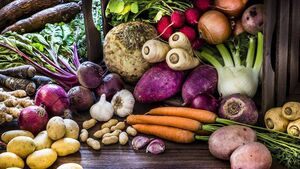Living Greener: Root veg offer great options for dinner

Most of us eat a few root vegetables every day, in the form of potatoes and carrots. Unfortunately, other root vegetables that grow perfectly well in Ireland have been long ignored
We have to work hard to preserve most vegetables without refrigeration. Some we preserve by adding vinegar until we’ve made their environment too acidic for most bacteria; in other words, pickling.
Others we can preserve in salt water, called brining or, confusingly, also pickling. Still others, like fruit and berries, we can preserve in sugar to make jam or syrup.
We can keep staples like beans, wheat, rice and corn dry and in bulk, and we build cloches, cold-frames and greenhouses to grow winter salad.
One class of vegetables, though, does not need most of these arrangements, and can be kept outside for much of the winter – roots. Buried underground they are safe from many pests, and the ambient temperature insulates them from killing frosts.
What we call root vegetables, of course, encompass many botanical families, and many of which are not technically roots but tubers (potatoes), corms (taro), rhizomes (ginger) or bulbs (onions). We can call them roots for convenience, though, and they all have similar functions; to store energy for the plant in the form of carbohydrates.
Most of us eat a few root vegetables every day, in the form of potatoes and carrots. Unfortunately, other root vegetables that grow perfectly well in Ireland have been long ignored.
Beetroots are rare here unless pickled, but can be cooked like carrots or made into a tasty salad. As popular as cabbages are in Ireland, few here have heard of the cabbage relative kohlrabi. Turnips are grown here, but few people grow or eat the similar mangelwurzels or rutabegas.
I see celery grown here but rarely celeriac, a relative bred not for its stalks -- which are edible but foul-tasting, I can assure you – but for its bulbous root as large as a child’s head. I grew scorzonera, a yellow-flowered dandelion relative that seemed to fall out of favour after the Victorian era, and its white-rooted, blue-flowered cousin salsify.
Some of these root crops might be available in the supermarket, and you can experiment with them before deciding to grow them. Try making them for supper in one of these ways:
Chips: When I lived in the USA, we sometimes had breakfast at a Cuban restaurant that always served chips – but instead of being chips made from potatoes, they were made from the roots of the desert yucca plant. We make chips – fries to Americans – from potatoes, but why not try making beetroot chips? How about mangelwurzel chips? Yam chips?
Crisps: Again, we eat slivers of deep-fried potato without thinking how many other possibilities there might be. We’ve made beetroot, turnip and parsnip crisps, and you could just as easily make crisps from many other roots -- swedes, yams, sweet potatoes rutabegas and many more.
Mashers: We have made mash from parsnips, turnips and yams, and there is no reason you could not do so with any of the roots listed above.
Roasting with meat: Surrounding meat with vegetables is one of the easiest ways to keep it moist as it cooks, and roasting also lets the fat and flavour soak into the vegetables. Next time you roast chicken, try doing so in a deep dish and almost covering it in garlic, beetroot, sweet potatoes, or any number of other possibilities.
Root salad: Kohlrabi can be eaten raw and whole like an apple, but most root vegetables are difficult to digest raw, (potatoes or sunchokes), too harsh in flavour (onions and ginger), or too woody (celeriac). You could solve these problems without cooking them by grating them like parmesan and mixed in a spicy lemon dressing. I mix carrots and beetroot into a salad with sesame oil, soy sauce, cayenne pepper and malt vinegar.
Gratin: Thinly sliced potatoes can be cooked in cream or white sauce to make a tasty dish, but why not mix in turnips, rutabegas or sunchokes for variety?
Soup: A good root soup can warm and nourish on a winter day, and can be mixed with whatever vegetables you have handy.
Drying: If you are able to dehydrate slivers of root vegetable – either in a solar dehydrator, an electric one or simply by hanging them up, you can then preserve them in jars until you need them in soup.





